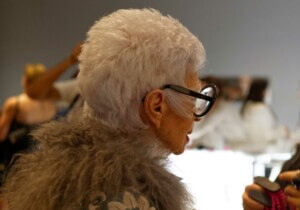Since Dutch designer Iris van Herpen opened her eponymous atelier in 2007, the brand has become the face of high-tech fashion. Often the first to embrace new technologies like laser cutting and 3D printing in her fluid and futuristic forms, van Herpen has designed pieces worn by the likes of Solange and Rihanna, and, on the streets of Paris this past July 1st, Céline Dion.
During the presentation of van Herpen’s latest collection during Paris’s Haute Couture week, titled Hypnosis, her already alien and energetic forms came alive. The clothing literally moved on the models as they passed through a large, also motorized, ring hung in the Élysée Montmartre.

Inspired by the fluidity and complexity of natural forms, van Herpen designed 19 different looks made from traditional materials like silk and satin, as well as aluminum and stainless steel. The fabric itself was guided by engineering, with plotter machines and laser cutters working alongside hand stitching.
What really stood out, though, were the actual moving parts. Dresses were mounted with metal pieces and fabric flanges that rotated around, and in the center of the runway was a large moving circle, a motorized ring called Omniverse by kinetic sculptor Anthony Howe, a “portal” designed to evoke the “universal life cycle,” according to the artist. The dresses’ moving components were devised by experimental sculptor Philip Beesley (PB), along with architect Rolf Seifert. The duo behind PB, who also led the design of the moving metal augmentations that sprout off the garments, generally works on public buildings and art, along with experimental installations—including immersive textile environments. The pair also have architectural relationships with the Living Architecture Systems Group, the School of Architecture and Faculty of Engineering at the University of Waterloo, the architectural practice of Rolf Seifert, and Riverside Architectural Press. It’s hard to think of a technological setting so radical since Alexander McQueen’s industrial robots to spray paint and dance along with the model in the Spring-Summer 1999 show.
The results of these collaborations shook up viewers along the stage and on Instagram alike, as they pushed the bar even higher for integrating fabrication and robotics technology in haute couture, both on the garments and off. Hopefully, with Liz Diller, Kazuyo Sejima, and Cini Bouery designing for Prada and a trained-architect behind Louis Vuitton, we’ll be seeing architectural thinking entering the fashion world both high and low more in the future.











